Three Blocks Of Washington Ave Diagonal Parking Now Back-In
The planning to reduce travel lanes from four to two on the three blocks of Washington Ave, from 18th to 21th, took place in 2007. The work was done in 2008. I was a paid consultant during the planning phase. At the time I lived in the Mt. Pleasant neighborhood and drove a motor scooter. In late 2007 I moved downtown and a few months later I had a stroke.
During the planning phase we debated angled parking — front-in vs. back-in. In 2007 I argued for front-in angled parking, which is how the street got striped. Since then the block West of Jefferson plus others toward Grand also reduced travel lanes with the addition of angled parking. But these blocks did back-in parking.
Front-in angled parking is much easier when it comes to parking your car but harder to see other motorists, motorcycles, or bicyclists when exiting the space. Last year we picked up friends at their loft at Washington Ave & Jefferson, I was driving and parked in a back-in space. I was nervous. but I did it first try. In hindsight I wish I’d argued for back-in parking initially.
Recently these blocks of Washington Ave were resurfaced and restriped — now with back-in parking. Let’s take a look:
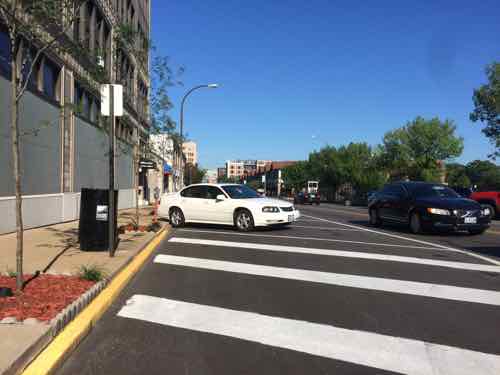
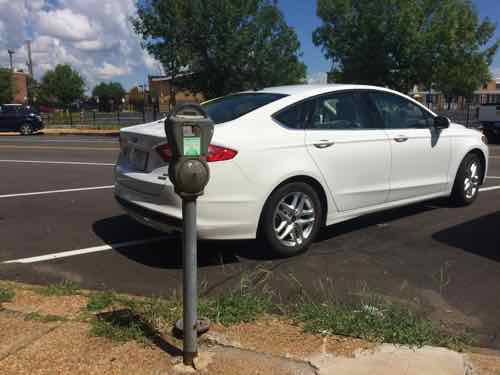
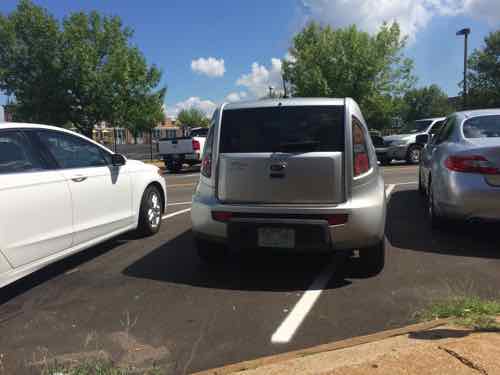
Out of 20+ cars only two weren’t within their respective spaces. Again, I wish I’d argued for this initially. The planning was prior to my being disabled, but I lobbied hard for good pedestrian crossings and disabled parking.
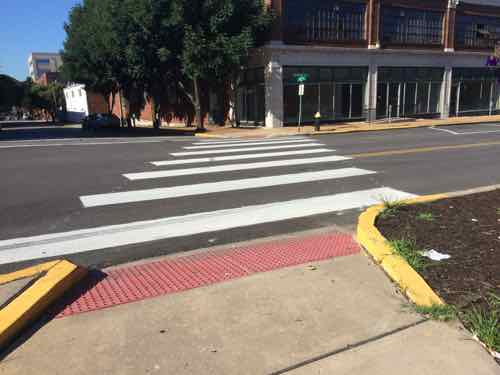
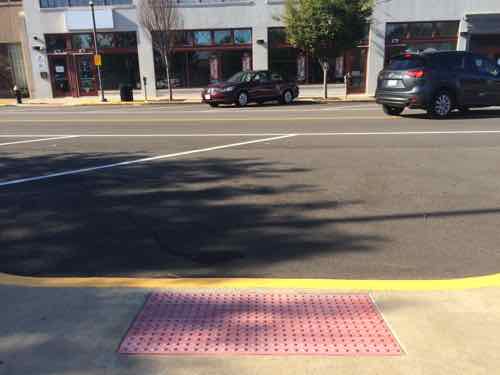
Two and a half hours later I returned to check out a few more things, the white Ford was in the same spot.
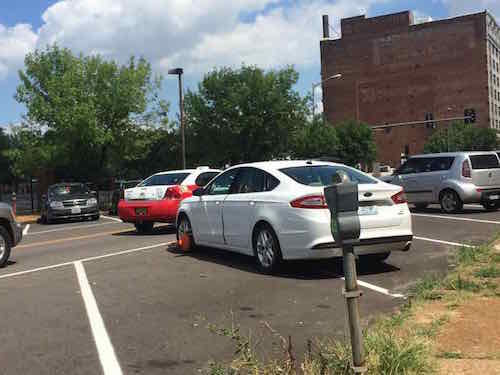
Like most aspects of driving, backing into a parking space just takes practice to master. Occasionally I back into our space in our parking garage, it does get easier. Some day I may drive over to Washington Ave to practice — this wasn’t on my driver’s test in 1983.
— Steve Patterson
With all the huge vehicles on the road these days, if you drive a smaller vehicle and happened to be parked next to one of these behemoths in a pull-in space, backing out into traffic is a crap shoot. I am glad the city is transitioning to back-in. The spaces around Lafayette Park were recently converted to back in. We attend the concerts there and slowly drivers are making the transition.
The people that “can’t” back in properly are likely the same ones that can’t pull in properly, either, much less line up the front of their vehicle with the post on the meter in a parallel parking space! Personally, I prefer back-in spaces – they’re much closer to parallel parking (to park), and given the increasing size of vehicles, combined with the ubiquity of “privacy” glass, backing out is a huge challenge, even with the cameras many vehicles now have.
If you can’t back into a parking spot between the lines, you shouldn’t be driving a car
Steve, the article on Continental Crosswalks that you link to says that they cost “$10,000 a pop”. Can that be right? That seems way too high to me. With LA installing 20,000 of these, that would be $200,000,000??
Keep digging – “The city plans to upgrade 19,770 crosswalks across Los Angeles. The cost is of the project is said to be $50 million, the average equivalent to $10,000 per intersection.” (4 crosswalks per intersection, $2,500 per crosswalk). The cost doesn’t seem to be out of line, since it’s a) California, b) design fees, in addition to labor and materials, c) it’s a government project, and d) if they’re doing it “right”, they’re using vinyl material, not paint, to lay down the markings, which should last multiple years.
I’ll argue that Continental crosswalks are just like anything else that’s new and different. New and different, not the actual design, is what attracts attention, at least for the short term. Over, the long term, familiarity breeds apathy, and you just end up where you started – see the proliferation of four-way stops, here in STL. The first ones probably made sense, now, they’re more of an irritation and do nothing to enhance “safety”, since everyone assumes “the other guy” won’t be rolling thru like they are!
Pederstrian safety (or the lack thereof), here in St. Louis, is way more of an enforcement (none) issue than a design issue, combined with a mindset among some pedestrians (who wander out into traffic far from any crosswalk) with the apparent attitude of “go ahead and hit me, I ned the money” . . .
Mid-block crosswalks are dangerous. Maybe the city realized that, and left the curb cuts just to continue to provide access to the adjacent accessible parking spaces?
In cities like St. Louis, where motorists don’t stop for pedestrians in crosswalks, you might be right about the danger. But no more dangerous than a crosswalk at a corner where motorists don’t have a stop sign/signal.
Take the block between 18th & 19th, it has parking on both sides but oh’ only the South side has any activities. Nobody parking on the North side is going to walk to 18th or 19th to cross.
The next block is similar, people may park on the opposite side of the street from their destination. As Washington Ave has low traffic volume people will cross mid-block.
It all boils down to enforcement. “In cities like St. Louis, where motorists don’t stop for pedestrians in crosswalks,” crosswalks are essentially irrelevent, as evidenced by some fairly common pedestrian behavior, jaywalking – it doesn’t matter where you cross, so why even worry about using (or marking) crosswalks?! Driving in California is completely different, since drivers are conditioned to see pedestrians and to stop for pedestrians in crosswalks. Why? Because there’s enforcemant, period! It’s part of the driving culture. You certainly, unfortunately, wouldn’t see this type of discussion, here, in the midwest: http://www.expertlaw.com/forums/showthread.php?t=109454
I’m not sure who thought that this was a good idea: https://youtu.be/6JT6wrUMTug